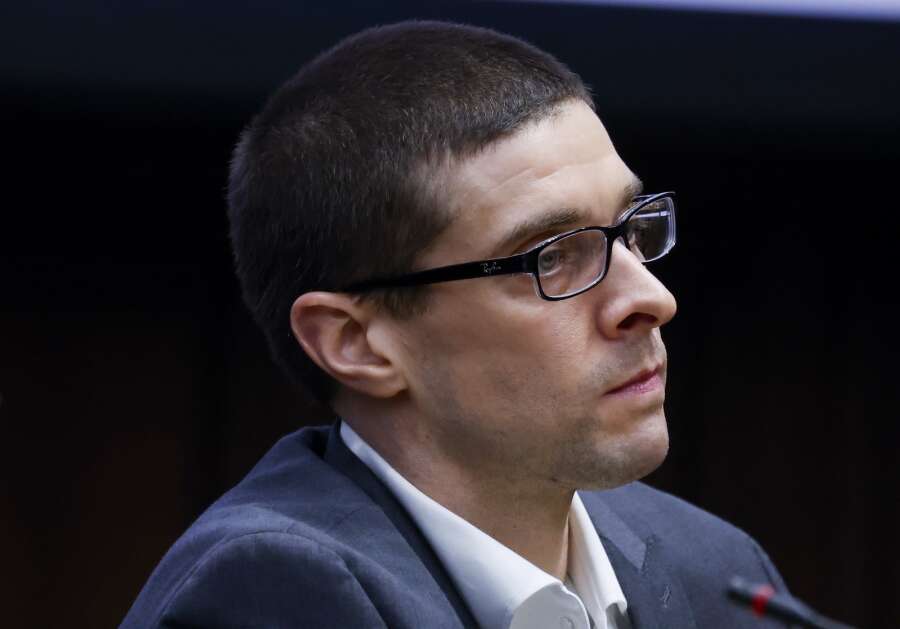The Gazette uses Instaread to provide audio versions of its articles. Some words might not be spoken correctly.
CEDAR RAPIDS A state medical examiner and forensic pathologist testified Friday that Chris Bagley, the Walker man Andrew Shaw is suspected of paying two men to kill, suffered 17 stab wounds and cuts to his neck, shoulder, abdomen, and leg.
Dr. Kelly Kruse, an associate Iowa state medical examiner, testified during Shaw’s first-degree murder prosecution that the wounds pierced his upper airway, larynx, jugular vein, heart, left lung, stomach, diaphragm, spleen, and belly, all of which passed through soft tissue muscles.
In Linn County District Court on Friday, jurors were shown graphic autopsy images of Bagley’s multiple stab wounds and the exhumation of his remains.
Drew Wagner, 39, of Cedar Rapids, who was found guilty of taking part in the deadly stabbing, lived near the yard where Bagley was buried. On December 14, 2018, Bagley was held down by Wagner while Johnny Blahnik Church, 38, of Marion, fatally stabbed him, according to trial testimony.
Shaw, 37, of Cedar Rapids, is accused of first-degree murder, conspiracy to commit a forcible felony, and solicitation to commit murder.
Along with Paul Hoff, 46, the owner of the mobile home where Bagley was killed, Wagner and Blahnik Church were found guilty in this case.
On Monday, the defense will begin once the prosecution concludes its case.
Bagley’s body wasn’t discovered by authorities until March 1, 2019. The corpse was removed from the east side of a detached garage at 4069 Soutter Ave. SE, where the ground was frozen and required heating.
According to Kruse, who participated in this procedure with law enforcement and a professor of anthropology from the University of Iowa, it took two days to remove his remains and a few more days for the thawing process at the state medical examiner’s office in Ankeny.
According to Kruse’s identifying images, Bagley was wrapped in a plastic tarp and a bedsheet when his body was discovered. To avoid further harm to the body, care was given as the body was lifted off the ground. According to Kruse, the chilly temperatures during the two-month burial period helped preserve the remains.
The clothes that Bagley, who weighed 170 pounds and stood 5 feet 9 inches tall, wore on the day of the attack—a T-shirt, sweatpants, socks, and sneakers—were buried with him. He wore a fanny pack around his waist and a crimson bandanna wrapped up and knotted around his neck.
Photos of his garment that Kruse recognized revealed ripped regions that matched stab wounds on Bagley’s torso and shoulder.
Three cutting wounds below his knee were among the 17 injuries he sustained. Those wounds were relatively superficial.
According to Kruse, the weapon, which was probably a knife, penetrated his torso in a downhill direction, causing stab wounds that went from front to back and back to front.
As is customary for medical examiners, Kruse testified that she matched the injuries to two knives that detectives had provided her and concluded that those kinds of knives might have been used.
According to earlier evidence, the two blades were discovered when police searched Blahnik Church’s Marion flat. When the search was carried out on February 27, 2019, neither knife tested positive for Bagley’s blood.
Additionally, Kruse sent Bagley’s urine and blood to be analyzed at a different lab that processes toxicology reports for the Iowa office. Bagley contained amphetamines, caffeine, nicotine, methamphetamine, and ethanol, which can be alcohol or the result of the body breaking down.
The study states that Bagley’s system contained 3,600 nanograms of meth per milliliter. According to Kruse, various people react differently to meth, and long-term use might alter a person’s tolerance.
Kruse came to the conclusion that homicide was the way of death and multiple sharp force injuries were the cause of death.
During the cross-examination, Kruse stated that high dosages of the medication have been known to induce aggressive behavior and hallucinations, and that 200–600 nanograms can result in violent behavior.
Wagner and Hoff testified that on the night of the deadly stabbing, all of the men were using meth and marijuana.
Former inmates testify about what Shaw told them
In additional testimony, two men who had previously been Shaw’s detainees in the county jails in Linn and Iowa described what Shaw had told them about the Bagley assault.
Judge David Cox of the Sixth Judicial District allowed the prosecution’s motion to prohibit broad media coverage of the men’s evidence, adding that the men’s safety prevented the witnesses from being named by name.
In May 2019, a man who was in the Linn County Jail with Shaw claimed that Shaw mentioned Bagley during a news broadcast. What happened to the last person that tried that (crap) with me, Shaw said.
Shaw reportedly claimed he wanted Bagley roughed up, according to the man, who received a 12-year federal term.
In order to receive a lighter sentence, Shaw’s attorney questioned him on cross if he had spoken to an FBI agent who claimed to have information about Shaw in this case.
The individual claimed he was unable to remember.
He responded negatively when asked if his knowledge had resulted in a lower federal sentence during redirection.
In March 2020, another man who shared a cell or pod with Shaw at the Iowa County Jail said that Shaw discussed Wagner and Bagley with him. Neither Shaw nor any of them were known to this prisoner.
The man claimed that Shaw informed him that it was the best money he had ever spent and that Bagley died like a bitch. Shaw’s remarks weren’t made in a single exchange. They occurred over a number of times when they were incarcerated together.
According to the man, some of these discussions took place after Shaw got family texts, photos, or other correspondence. He is aware that Shaw lost it after receiving an email from his brother, Chris Shaw, in March—possibly around St. Patrick’s Day. He then said that it was the best money he had ever spent.
Shaw’s brother informed him that, among other things, the Bagley family was playing pranks on him by sharing content on social media.
This prisoner further said that Shaw told him that Wagner received $10,000 for killing Bagley and that Blahnik Church was just a jerk. Shaw added that Hoff deals in drugs.
Shaw told the inmate in another comment that Bagley was buried in a driveway and that the body was dug out with a skid loader.
According to this prisoner, he was found guilty and spent more than 48 months behind bars. After being released, he had to go back to prison for violating the terms of his supervised release. He was found guilty of possessing a firearm by someone who was not authorized to do so.
On Monday, he will continue to testify.
Trish Mehaffey writes for The Gazette about state and federal courts.
Comments: [email protected]; (319) 398-8318






